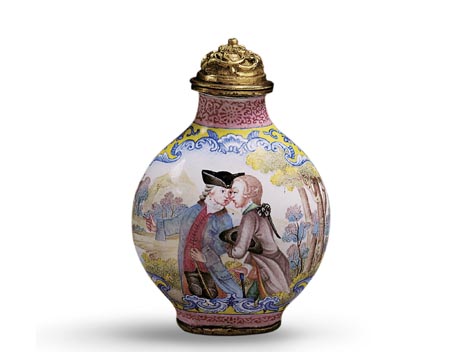
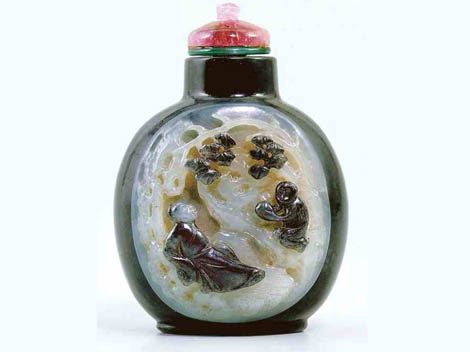
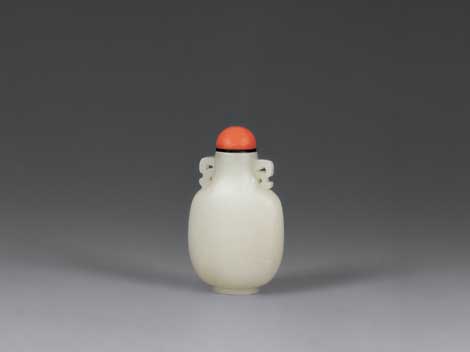
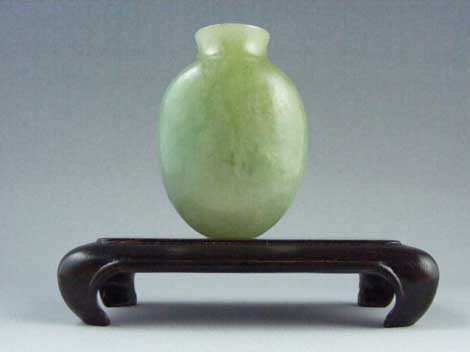
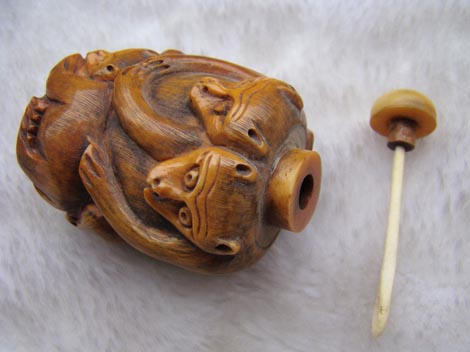
Origin of snuff bottles
While snuff first came to China from the West, the snuff bottle is an absolute Chinese invention which combines the Chinese and western cultures. It's said that snuff was introduced to China between the end of Ming Dynasty (1368-1644) and the beginning of Qing Dynasty (1644-1911) by Mattel Ricci. Due to its mild anesthetic properties which help people relax, it was widely appreciated by the royal family, who belonged to the Man ethnic minority. As time passed, snuff gradually took on oriental characteristics and eventually, snuff bottles emerged.
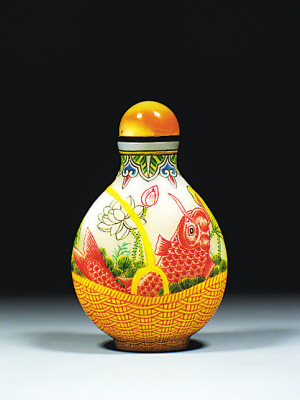
Snuff bottles continued to be in fashion for over two hundred years until the end of the Qing dynasty, and is an art form connected closely with imperial tastes. Initially only used within palace circles, snuff bottles were soon collected and used among literary and scholarly circles in Qing society, as well as the merchant classes. Incorporating the most sophisticated techniques of China's applied arts, snuff bottles are the crystallized product of generations of superb craftsmanship and artistic achievements.
The craft of snuff bottle-making dates back to Ming dynasty, and came to full flourish in Qing dynasty. In terms of material and manufacturing method, snuff bottles include fabric bottles, china bottles, stone bottles, metal bottles, interior inscription bottles, and enamel bottles etc. They are small in size, versatile in shape, and well-known for their artistic merit and sophisticated workmanship. They are easy to collect and play with. Compared with chinaware of Ming and Qing dynasties, the mini snuff bottles are cute and delicate, the "Thumbelinas" of Chinese art.
Chinese snuff bottle are considered by some to be the epitome of Chinese artwork, as it involves painting, calligraphy, carving, inlaying, handicrafts, ceramics, glassware, and enamel etc. This is why Chinese snuff bottles have been well-known all over the world for years. During the Qing Dynasty, bottles were mainly produced in of Guangzhou, Beijing, Boshan (of Shandong Province), Inner-Mongolia, Liaoning Province and Tibet. Inner-Mongolia is famous for its silver snuff bottles, Liaoning for agate ones, and Tibet for metal ones.
Snuff bottle's characteristics in its heyday
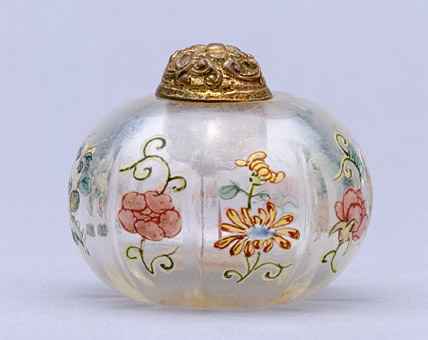
Due to its cute and original outline; various types of materials and sophisticated workmanship, the snuff bottle was widely appreciated by the royal family, especially by the Emperor Kangxi, Yongzheng and Qianlong.
It was recorded in Gu Wan Zhi Nan by Zhao Ruzhen that snuff was as important as food and sleep in the emperors' daily lives and of course snuff bottles became an indispensable part as well.
Kangxi's period
The snuff bottles of Kangxi's period were mainly under glazed and dyed with cobalt. Therefore, the bottles are mostly ornate with red as the dominant hue.
The main motifs of this time were dragons, horses, hares and fish, etc. According to tradition, only the Emperor, his sons and princes of the first and second ranks were permitted to own works of art illustrated with five-clawed dragons. Four-clawed dragons were restricted to princes of the third and fourth ranks, while the common folk had to be content with a dragon bearing three claws.
The horse was another animal frequently used in decorative work. The horse is one of the Seven Treasures of Buddhism. It symbolizes speed, perseverance, rank, power and wealth. The symbolism of wealth and power came about because the horse carried those of importance.
The hare was also often found on snuff bottles, representing a wish for long life and even immortality. In Chinese tradition it is believed that if one attains a sufficiently high standard of morality and enlightenment, one will become one of the immortals.
The fish, as an emblem of wealth, harmony and marital bliss, was used in a variety of decorative ways.
Yongzheng's period
Comparatively speaking, the snuff bottles of Yongzheng's period were more likely to be made of pottery and porcelain because the emperor favored these two materials. Purple was added in the selection of colors to symbolize the dignity and elegancy of the royal family.
Besides this, the motif adopted by craftsmen also changed from the dragon and horse to blossoms and beautiful sceneries, in particular the famous twisted lotus. Bamboo was a frequent motif. Because of its durability and being evergreen it has come, along with many other symbols, to signify longevity.
Unlike the incredibly ornate designs of Kangxi's period, the snuff bottles of Yongzheng's period were famous for their simplicity and elegance.
Qianlong's period
During Qianlong's reign, the snuff bottles became more diversified than before in design and outline. There emerged not only some established shapes such as gourd-shaped, spherical, and egg-shaped styles, but also flower, animal as well as human-shaped ones. Colors also changed from monochromatic to vivid collections, such as pink, black, gold, dark red and so on.
The motifs used in this period almost always aimed to bring wealth, health, good luck, longevity, and even immortality to the owner of an artifact. They were often used by gift-bearers to express a subtle wish for the recipient.
However, the making and manufacturing of snuff bottles decreased with the fall of the Qing Dynasty, evident in the inferior material, color collocation and design of newer creations.
"Painted interior" bottles
Without a doubt, the class of bottle that arouses most interest in the non-collector is the painted interior bottle. These are glass bottles which have pictures and often calligraphy painted on the inside surface of the glass.
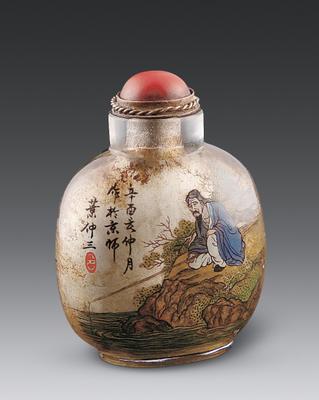
The earliest painted interior bottles are thought to have been made in the period between 1820 and 1830s, by then, the beauty of a snuff bottle was probably more important than its practical applications—and considering this—few would have been used for holding snuff. Painted interior bottles are still made today—expensively for collectors and inexpensively as souvenirs.
To make a painted interior bottle, painter must work on a polished surface inside through the mouth of a bottle. Fine pictures are painted. It looks magnificent and smooth and gains much admiration. In Europe a painted interior bottle is usually fairly expensive.
It is said that the art form first emerged sometime around the reigns of Qianlong and Jiaqing's, so it has been around for about 200 years. One legend has it that an official went to Beijing for business in the later years of Qianlong's reign and became addicted to snuff. When his business failed and money began to run out, he had to lodge in a poor temple. With no money to buy new snuff, he dug the last remnants of snuff from his bottle with a smoke-pick, leaving many marks in it. Later a Buddhist monk was inspired by the marks he made, and tried using a hook to scratch a picture of bamboo on the inside surface a transparent bottle. And thus the first painted interior snuff bottle was born.
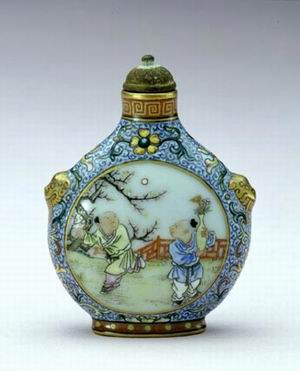
Like other types of snuff bottles, the range of subject matter used on painted interior bottles is without limit. It includes scenery, fish, birds, poems, and even portraits. They are a testament to the skill and inventiveness of Chinese craftsmen.




